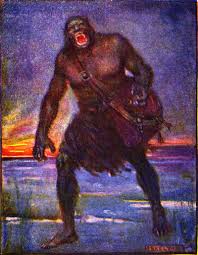
Friday
My son Toby Wilson-Bates just alerted me to a Dorothy Kim article about how J.R.R. Tolkien, even as he brought general attention to Beowulf, also circumscribed how people interpreted it. The Oxford don could only see it as a white, male hero story and, more disturbingly, he shut out scholars of other races who might have interpreted it differently.
While I find the article overly opaque and convoluted, it does alert us to Tolkien’s prejudices. It also provides me an opportunity to reflect on how literary works are more complex than the writers who authored them or the scholars who study them. This is certainly true of Beowulf and somewhat true (because it’s a lesser work) of Lord of the Rings.
Tolkien’s landmark essay “Beowulf: The Monsters and the Critics” elevated the epic from an interesting historical document to the masterpiece that launched Britain’s literary greatness. Since then, however, Kim says that critics have read it “through the white gaze and a preserve of white English heritage.” Tolkien, she argues in an elliptical and not altogether convincing manner, regarded Grendel as a black man. I’m less skeptical that his concern was “solidifying white Englishness and English identity.” While he “abhorred fascism and antisemitism,” he “upheld the English empire’s white supremacy.”
Kim then contrasts Tolkien’s vision with Toni Morrison’s. While the white author focuses on Beowulf, the black author focuses on Grendel and his mother, regarding them as “raced and marginal figures.” In Morrison’s view, Grendel represents the dispossessed, one who yearns “for nurture and community.” I haven’t read Morrison’s essay but, by Kim’s account, it sounds like she regards him as a Bigger Thomas, the protagonist of Richard Wright’s Native Son.
That Tolkien has racial prejudices I am willing to grant, to which I would add gender and class prejudices. In Lord of the Rings, the good guys are Nordic-looking Rangers of the North (Aragorn), elves that resemble British yeomen out of the Robin Hood stories, and the very white Riders of Rohan while the bad guys (the Orcs) are Slavic-looking proles who threaten to overwhelm the comfortably middle class Shire. Women, meanwhile, are in scarce supply.
I also grant that his interpretation of Beowulf is lacking, especially as it omits any discussion of Grendel’s Mother. (In other words, he overlooks women once again.) This is why diversity in academic scholarship is vital: women and people of color spot things overlooked by scholars with Tolkien’s demographics.
But Beowulf is greater than either his or Morrison’s interpretations of it, and I believe that Lord of the Rings transcends Tolkien’s racism, classism, and sexism as well. Beowulf is one of the great literary works about violence—it ranks up there with the Iliad—while Lord of the Rings changed the course of fantasy fiction.
As I see it, Beowulf captures how violence hollows us out and distorts our souls. Tolkien may or may not have regarded Grendel as black, but the monster’s resentful rage maps easily on to our white supremacists, who themselves feel dispossessed.
Grendel’s Mother, meanwhile, I regard as the vengeful rage that wants others to experience the hurt she feels. To apply one instance of Tolkien’s own countrymen yielding to her rage, Britain firebombed Dresden, an open city for refugees of no strategic importance, in revenge for the bombing of London.
The Beowulf poet could create this timeless monster because he had seen up-close his culture’s endless blood feuds. If he imagined this monster as a woman and a mother, it’s because no rage seemed fiercer to warriors than that of a mother who has lost her son. Think of it as Mother Bear rage.
In other words, I don’t see Beowulf’s monsters as limited to any demographic but rather as archetypes of our most destructive impulses. In his society, the monstrosity could consume disaffected warriors (Grendel resentment), grieving warriors (mother vengeance) and paranoid rulers (dragon rage). Every age and country has its own version of these three monsters.
To touch briefly on Lord of the Rings, it suffers from some of the author’s blind spots. Fantasist Terry Pratchett’s Snuff, for instance, exposes Tolkien’s one-dimensional depiction of goblins by giving them personalities, even as British gentry hunt them down or ruthlessly exploit them. But Rings also shows, through compelling storytelling, the seductive lure of power. Having witnessed Europe’s 20th century madness from the front row, Tolkien created a drama that can be used to expose Britain’s Brexit arrogance as much as it reveals Hitler’s or Stalin’s ambitions.
To reiterate my basic point: while we should call out literary works for their shortcomings, we should not overlook their greatness in the process.

